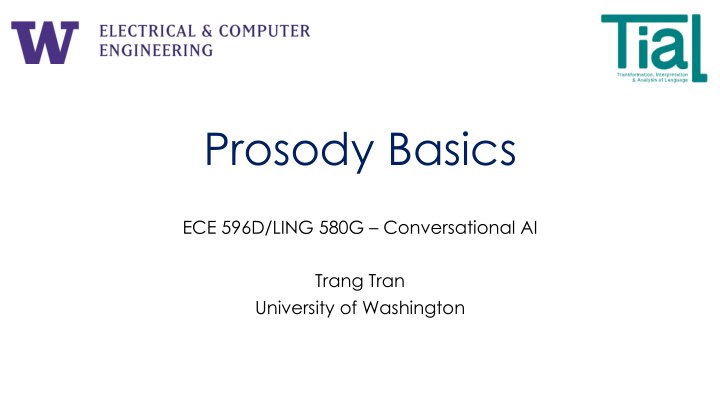



Prosody Basics ECE 596D/LING 580G – Conversational AI Trang Tran University of Washington
Agenda • Announcements: • Final presentations + demo (15 mins); “poster” session • Monday, June 10, ECE 303, 2-4pm • Amazon guests • Background • Prosody: definitions & conventions • Prosody in human communication • Prosody in language technology • Prosody Control in Alexa • Quick test interface • Speech Synthesis Mark-up Language (SSML) • Project work time 2
Outline • Background • Prosody: definitions & conventions • Prosody in human communication • Prosody in language technology • Prosody Control in Alexa • Quick test interface • Speech Synthesis Mark-up Language (SSML) • Project work time 3
Background: Prosody • Aspects of speech communicating information beyond written words • PERmit vs. perMIT; RECord vs. reCORD (meaning) • “Mary knows many languages, you know.” vs. “Mary knows many languages (that) you know.” (syntax) • “You want coffee?” vs. “You want coffee.” (intent) • “Yeah, sure.” vs. “YEAH! SURE!” (sentiment) • Prosody in human communication: common & essential • Prosody in AI systems: important but limited • Speech (input) understanding: recognition, parsing • Speech (output) generation: mostly neutral 4
Prosody Representation • Symbolic level: • Prominence: relative salience of • Correlates: elements in utterance • Increased pitch range, loudness for • Phrasing: grouping of words in emphasis utterance • Pauses, longer durations preceding • Acoustic cues: phrase boundaries • Timing, duration • Pitch (F0), intonation patterns • Energy è Mapping between acoustic & è Acoustic cues individually and symbolic levels is complex; in combination signal challenging to annotate prominence and phrasing 5
Common annotation system: ToBI ToBI Example Sequence of H(igh) & L(ow) tones Break indices: 0-4 From: https://ocw.mit.edu/courses/electrical-engineering-and-computer-science/6-911-transcribing-prosodic- structure-of-spoken-utterances-with-tobi-january-iap-2006/lecture-notes/chapter2_3/ 6
Common annotation system: ToBI ToBI Example Sequence of H(igh) & L(ow) tones Break indices: 0-4 From: https://ocw.mit.edu/courses/electrical-engineering-and-computer-science/6-911-transcribing-prosodic- structure-of-spoken-utterances-with-tobi-january-iap-2006/lecture-notes/chapter2_3/ 7
Prosody: Relation to Syntax & Meaning • Relation to syntax • Prosodic boundaries correlate with syntactic boundaries (Grosjean et al., 1979) • Resolve structural ambiguities (Price et al., 1991) Mary knows many languages you know [pause] [reduced] vs. Mary knows many languages you know [prominent] 8
Prosody in Parsing Input: Mary knows many languages. • Parsing: Identifying syntactic structure of a sentence ROOT Output: • Challenges for speech data: S • Lacks common cues in written NP VP . text NNP VBZ NP . • Disfluencies: filled pauses, [edits] repairs Mary knows JJ NNS • Previous works: many languages • Gain from prosody was negative or minimal Input with disfluencies: • Need explicit (expensive) [she knew] mary knows many uh languages annotations (ToBI) 9
Prosody: Relation to Syntax & Meaning • Relation to syntax • Prosodic boundaries correlate with syntactic boundaries (Grosjean et al., 1979) • Resolve structural ambiguities (Price et al., 1991) • Relation to meaning • Prominence signals entity importance (Grosz, 1977) • Prominence signals given/new information (Halliday, 1967; Huang & Hirschberg, 2015) Mary knows many languages vs. Mary knows many languages 10
Prosody: Relation to Syntax & Meaning • Relation to syntax Useful for • Prosodic boundaries correlate with syntactic understanding boundaries (Grosjean et al., 1979) structure • Resolve structural ambiguities (Price et al., 1991) (parsing) • Relation to meaning Useful for • Prominence signals entity importance (Grosz, 1977) generation • Prominence signals given/new information (Halliday, (concept-to- 1967; Huang & Hirschberg, 2015) speech) 11
Prosody in Generation • TTS (text-to-speech): • input = unconstrained text context • controlling prosody: independent intensive • text analysis signal • prosody (ToBI) prediction processing; • waveform generation/modification prone to • CTS (concept-to-speech): distortion • input = intent-defined text predefined • controlling prosody: schemata • from intent • waveform generation/modification • External prosody control: available in most • Markup languages: SSML , Sable commercial systems 12
Common Challenges • Systems like ToBI • expensive to annotate • even experts disagree • language-dependent • Integration of discrete (words) with continuous (acoustics) signals • Studies on prosody: mostly in controlled, read speech • In many tasks: ultimate goal, reference signal is still tied to words • Recognition, parsing • TTS, CTS: good quality on neutral, read style 13
Outline • Background • Prosody: definitions & conventions • Prosody in human communication • Prosody in language technology • Prosody Control in Alexa • Quick test interface • Speech Synthesis Mark-up Language (SSML) • Project work time 14
Quick Test Interface 15
SSML • Speech Synthesis Markup Language • Giving users (limited) control over prosody – can change pitch, speech rate, voice, etc. • https://developer.amazon.com/docs/custom-skills/speech- synthesis-markup-language-ssml-reference.html • https://developer.amazon.com/docs/custom-skills/speechcon- reference-interjections-english-us.html • Demo 16
Outline • Background • Prosody: definitions & conventions • Prosody in human communication • Prosody in language technology • Prosody Control in Alexa • Quick test interface • Speech Synthesis Mark-up Language (SSML) • Project work time 17
Extra Slides 18
Prosody in Education Applications • Assessment • Prosodic & rhythm sensitivity correlates with reading ability • Better readers produce pitch & pause patterns that align with syntax • Implications • Early exposure to diverse prosody affects later academic success • Interactive learning environments are critical, but not always available in low socio-economic communities • Social robots • Adaptive robots encourage learning, especially with expressive prosody • https://youtu.be/4zuaL7hIYq0 19
Recommend
More recommend